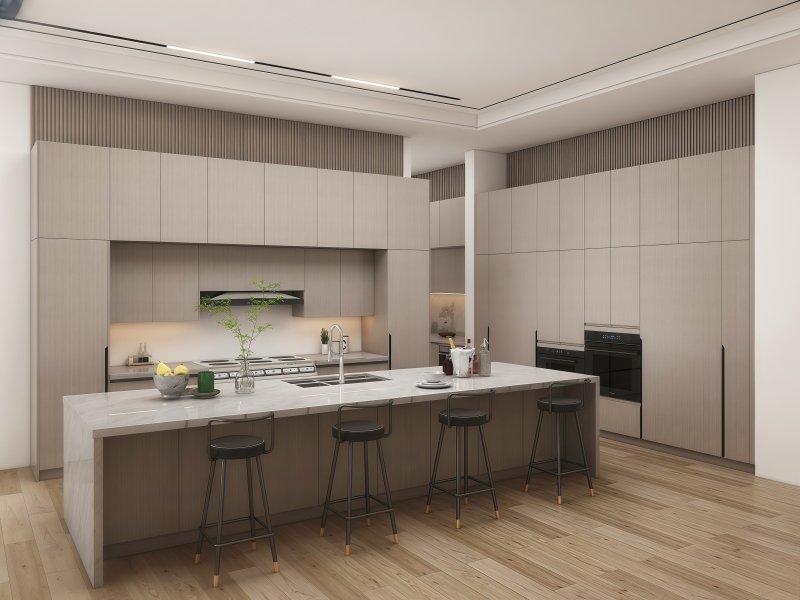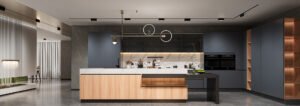When it comes to home organization and storage solutions, closets and wardrobes are essential pieces of furniture. While they serve similar purposes, there are distinct differences between the two that can impact their functionality and suitability for different spaces. Today, Cs Home will delve into these differences, providing you with the information needed to make an informed choice for your home.
What is a Closet?
A closet is a small, enclosed space within a room, typically built into the wall, used for storing clothes, shoes, and other personal items. Closets are integral parts of most homes, offering various configurations to meet different storage needs.
Key Features of Closets:
- Built-in Structure: Closets are often built into the architecture of a room, utilizing vertical space without occupying additional floor space. This makes them a space-efficient solution for storage.
- Variety of Types: There are several types of wall wardrobe, including walk-in closets, reach-in closets, and linen closets. Each type serves specific storage purposes.
- Storage Components: Wall closets can include shelves, hanging rods, drawers, and sometimes even built-in shoe racks or other organizers.
- Customization: Wooden wardrobe closet can be customized with various storage solutions to fit individual needs. Adjustable shelves, pull-out baskets, and built-in lighting are common features.
Advantages of Closets:
- Space Efficiency: Built into the walls, built in closet do not take up additional floor space, making them ideal for smaller rooms.
- Closet Organization: Cabinet closets provide a designated space for storing clothes and personal items, helping to keep the room tidy and organized.
- Customization Options: Closets can be tailored to fit specific storage needs with adjustable components and built-in organizers.

What is a Wardrobe?
A wardrobe, also known as an armoire, is a free-standing piece of furniture used for storing clothes and other items. Unlike closets, wooden wardrobes can be moved and rearranged as needed, offering more flexibility in home design.
Key Features of Wardrobes:
- Free-standing Closet Structure: Wardrobes are not built into the wall; they are independent pieces of furniture that can be placed anywhere in the room.
- Design Variety: Wardrobes come in various designs, including single door wardrobe, double door wardrobe, or triple door wardrobe configurations. Some feature mirrors, intricate woodwork, or sleek, modern finishes.
- Internal Storage: Bedroom Wardrobes typically include hanging space for clothes, shelves, and drawers for additional storage. Some may also have compartments for shoes and accessories.
- Portability: Since wardrobes are free-standing, they can be moved and rearranged as needed, providing flexibility in room design and layout.
Advantages of Wardrobes:
- Flexibility: Cabinet closet can be placed anywhere in the room and easily moved if needed, offering greater design flexibility.
- Aesthetic Appeal: Available in a wide range of designs, wardrobes can enhance the aesthetic appeal of a room.Comprehensive Storage: Wardrobes offer a combination of hanging space, shelves, and drawers, providing versatile storage options.

Key Differences Between Closets and Wardrobes
1) Structure:
- Closets: Built-in to the architecture of the room, utilizing wall space and leaving the floor space open.
- Wall Cupboard: Free-standing pieces of furniture that can be moved and placed anywhere in the room.
2) Flexibility:
- Closets: Once built, closets are permanent and cannot be moved. They are integrated into the room’s structure.
- Wardrobes: Can be moved and rearranged as needed, providing greater flexibility in room layout and design.
3) Storage Components:
- Armoire Closets: Typically include hanging rods, shelves, and sometimes built-in organizers or shoe racks.
- Wardrobes: Offer a combination of hanging space, shelves, and drawers, and may also include compartments for accessories.
4) Customization:
- Cabinet Closets: Customizable with built-in storage solutions like adjustable shelves and pull-out baskets.
- Bedroom Armoire: Offer customization options in terms of internal storage configurations and external design features like mirrors and woodwork.
5) Aesthetic Appeal:
- Closets: Integrated into the room’s architecture, closets offer a seamless and minimalist look.
- Wooden Cupboard for Clothes: Available in a variety of designs and finishes, wardrobes can serve as a focal point in a room, adding to its aesthetic appeal.
CS Home’s Closet and Wardrobes Offerings
At CS Home, we provide a wide range of closets and wardrobes to suit every need. Here are some examples of what we offer:
Closets:
- Walk-in Closets: Spacious and luxurious, offering ample storage for clothes, shoes, and accessories.
- Reach-in Closets: Ideal for smaller spaces, with efficient use of vertical storage.
- Linen Closets: Perfect for storing bed linens, towels, and other household items.
Wardrobes:
- Overall Cabinet: Comprehensive storage solutions for clothing and personal items.
- TV Cabinet: Stylish and functional, providing storage for media equipment.
- Bookcase and Wine Cabinet: Elegant designs for organizing books and showcasing your wine collection.
- Entrance Cabinet: Ideal for storing coats, shoes, and accessories in the entryway.
Choosing the Right Furniture
When deciding between a closet and a wardrobe, consider the following factors:
- Space Available: Measure the dimensions of your room to determine whether a built-in closet or a free-standing wardrobe would be more suitable.
- Storage Needs: Assess your storage requirements. If you have a large clothing collection or specific items to store, choose the option that best meets those needs.
- Design Preferences: Consider the overall style and decor of your home. Closets offer a seamless look, while wardrobes can add a decorative element to the room.
- Flexibility: Think about how often you might want to rearrange your room. If you prefer flexibility, a wardrobe might be the better choice.
Conclusion
Understanding the differences between closets and wardrobes is essential for making informed decisions about home storage solutions. Both options offer unique advantages and can significantly enhance the functionality and aesthetic appeal of your home. At CS Home, we provide high-quality closets and wardrobes tailored to meet your specific needs. Explore our range today to find the perfect solution for your home.
By selecting the right storage solution, you can create a more organized, functional, and visually appealing living space. Whether you opt for a closet or a wardrobe, make sure it aligns with your storage needs, space constraints, and design preferences. With the right choice, you can transform your home into a well-organized and stylish sanctuary.
Q1. What is the main difference between a closet and a wardrobe?
A1:
Closet: Built-in structure, integrated into the room’s architecture, primarily for storing clothes, shoes, and personal items.
Wardrobe: Free-standing piece of furniture, flexible in placement, used for storing clothes and other items.
Q2. Can both closets and wardrobes be customized?
A2: Yes: Both can be customized. Closets can have adjustable shelves, drawers, and built-in organizers. Wardrobes can also be customized with various internal storage configurations and design features like mirrors.
Q3. Where are closets and wardrobes typically placed in a home?
A3:
Closets: Commonly built into bedrooms, hallways, and other rooms where space allows.
Wardrobes: Typically placed in bedrooms but can be moved to other rooms as needed.
Q4. What are the advantages of using a wardrobe over a closet?
A4:
Flexibility: Wardrobes can be moved and rearranged as needed, providing greater flexibility in room design.
Aesthetic Appeal: Available in various designs, wardrobes can enhance the visual appeal of a room.
Q5. How does CS Home cater to different storage needs with its closets and wardrobes?
A5:
Closets: Offer solutions like walk-in closets, reach-in closets, and linen closets with customizable storage components.
Wardrobes: Provide comprehensive storage solutions with stylish designs, including overall cabinets, TV cabinets, and bookcases.





